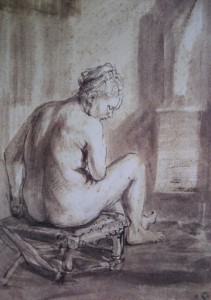 B1121 |
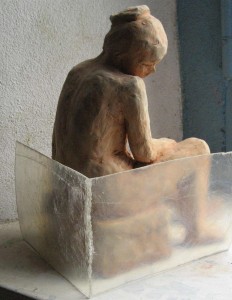 B1121 maquette with space envelope |
My favourite of all Rembrandt’s life drawings can be analysed in a sculptural way. B1121 is one of several drawings Rembrandt made of Hendrijke in his search for a pose for the Bathsheba in the Louvre. Her stool parallels the two sides of the block from which she could be carved. (Rembrandt seems to have had a natural feeling for sculpture though there is no evidence that he ever made any.) The light illuminates the side plane and strikes across her back defining the forms exquisitely. This is no idealized goddess but a beloved mistress seen as she truly was: no longer in the first bloom of youth. Not the rounded stereotype of the Renaissance but there, to the very life so that I have been able to make a little sculpted maquette of her. Her knee is seen with just that extra squareness about it that Sickert described as typical of Rembrandt (in his appreciation of The Polish Rider). The squareness serves to define the parallel between the top of the knee and the back plane of the space envelope. Degas often uses the same kind of device.
Every mark Rembrandt makes is defining form in space. I made a copy of this drawing during my first year at Camberwell. I hope that lesson will stay with me always. It was a defining moment.
On the other hand the gang of three (from The British Museum, The Rijksmusem and The Boymans in Rotterdam) who met regularly to coordinate their “findings” take a very different view. Mr. Schatborn, (Rijksmuseum) warns “only very few (of Rembrandt’s life drawings) can be assumed with any certainty to have been done by the artist himself”. Mr.Giltaij (Rotterdam) finds the stove in this drawing “incoherent…while the modelling of the back gives the impression of being over detailed and cautious…the contours (of the figure) are weak and hesitant” these appalling misjudgments fly in the face of all previous scholarship, not just mine! I wonder have they ever come across Kandinski’s maxim? – line becomes plane.
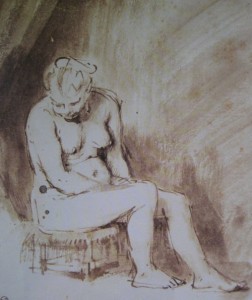
B1122
This drawing is usually paired with another of Hendrijke in the same pose (B1122) because as Schatborn admits “at first sight the two drawing resemble one another very closely… the nearly identical position of the two figures on the surface of the page – the use of the same ink, the lines that do not describe with precision and touches of transparent water colour”. The two drawings are indeed so identical in feeling, in materials and treatment that it is impossible for any one but an “expert”to doubt that Rembrandt did them both, probably in the same sitting. None the less, the greater of the two (B1121) is now attributed to Aert de Gelder and the lesser is still a Rembrandt. I say lesser because the front plane of her chest is very mildly out of geometry with the side plane. One can see that Hendrijke has slumped forward a little while posing because of the repositioning of her left shoulder. Her left breast was also repositioned but not sufficiently. Otherwise Rembrandt’s sense of form and structure are of the same very high, one could say, canonical order, in both. Is it at all likely that Rembrandt would have invited young Aert in to share this intimate drawing session with his mistress? In the Getty catalogue other students are credited with drawings of Hendrijke.
What can one say, the temerity of the gang knocks the breath out of me. How is it possible to teach drawing in a culture that can tolerate such minds in the top echelons of Rembrandt studies? I saw these two drawings hanging together in the Rijksmuseum exhibition, “Rembrandt and his Workshop”. I nearly had a fit.There was no workshop. It is a modern fabrication to explain away the many painting the RRP have de-attributed. Rembrandt had a good, expensive, school of painting. He was not that great at teaching drawing judging by results. His students are nothing like the master, few are even tolerable draughtsmen but there are hundreds of Rembrandt drawings re-attributed by the “experts” in the recent past to his dull students! Ferdinand Bol has been particularly fortunate in this respect.)
I have said quite a lot about the mistreatment of Rembrandt’s life drawings in my website
www.saveRembrandt.org.uk (save him from the experts, of course.) (For more about Woman seated on a stool take this link) I shall probably say a good bit more here. Please if there is anyone left out there who understands what I am talking about, help me in this crusade. I issued three news sheets at the time of the “Rembrandt and his Workshop” exhibitions (1991). I put on a show in St Martin’s in the Fields for the day of the opening in Trafalgar Square, it was very well received by the hundreds who saw it but for all my efforts the establishment marches on unflinching.
Art matters.
We need to demonstrate in the street, if necessary to stop the rot. Wilfred Owen wrote-
“Reach at that arrogance that deserves thy harm,
And beat it down before its sins grow worse!”
Look around you and see the results on the younger generation who no longer look to Rembrandt for guidance; they can no longer trust him. The gang have no idea of the harm they have done. They are victims of a truly terrible training. The whole apparatus of Rembrandt scholarship must be stopped; and only restarted with an entirely new set of criteria. One of which might be a minimum of three years at a good art school before taking up art history!
I would be pleased to hear from anyone from Harvard where I said diplomatically (in 1978) what I say here, more stridently.
Good friends have suggest I should be more moderate, more reasonable in my approach to the “experts”. In 1977 I was most reasonable, 35 years later I feel it is reasonable to follow Green Peace’s excellent example – be reasonable when you have people to reason with.
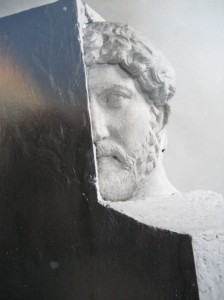 Hadrian with his nose in the corner of the block |
I have made an analysis of a Head of Hadrian, first published in Apollo Magazine (1978) and summarized in my book on sculpture ( Sculpture, the Art and the Practice isbn 0-9523568-1-3). Essentially it shows how the survey geometry used by the Romans to copy in stone, has had a great and lasting effect on European art; at least as great as the legacy of ancient Greek sculpture. It was after all much more widely distributed and admired through out Europe. Prior to the arrival of the Elgin marbles in London, Greek sculpture was known in Rome a little and hardly anywhere else.
I use Holbein as the greatest exemplar of the alternative tradition before Rembrandt. ( I can rekindle a sculpted head from any one of Holbein’s drawings, they are so brilliantly descriptive of the three dimensional world.) Rembrandt made a beautiful copy of a Holbein, which in terms of geometry is considerably better than the original, look at the volume of the head and the general pose. Alas it is not included in any of the catalogues known to me, though it is catalogued as a Rembrandt in Oslo, its home. Fortunately, I have a photocopy.
Virtually all of Rembrandt’s observed works show some sign of this geometry. For works he constructed from “imagination” he was forced back onto the Greek/Renaissance tradition but he seemed to make a point of guying it when he did so.“Rembrandt was taught by nature and by no other law.”
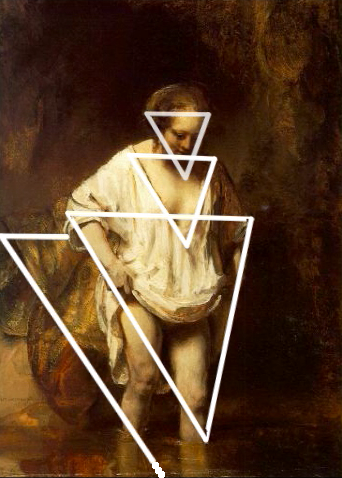 Woman Wading with geometry |
His “Wading Hendrijke” in The National Gallery, London is a magnificent oil sketch held together by a series of isosceles triangles laid parallel in space with the triangle that defines the neck-line of her shift. Rembrandt widened the geometry of Holbein to include space as well as solid. I call the space around Hendrijke – a space envelope. Another way of looking at the space envelope is to see it as the shape of stone a sculptor would use to carve the figure. In this case if we start from a block – by putting her head into the corner (like Hadrian’s nose) we can save half the block by sawing it in half, along the diagonal. Both pieces would make a space envelope for Hendrijke. (This concept is further explained in my sculpture book).
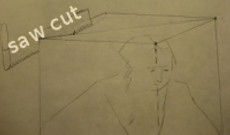 Space envelope for Wading Woman |
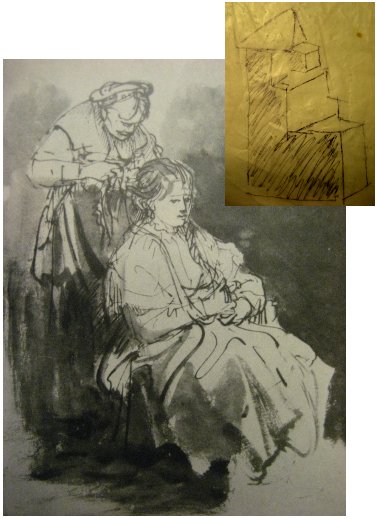 Rembrandt's drawing B395 with geometric diagram |
Rembrandt’s geometry is broader than Holbein’s, more implied than stated. An artist learns his syntax as we all learn our verbal syntax, by usage. I hope Rembrandt would understand what I am talking about but I am not certain that he would. If it helps us appreciate his work that is all that matters to me.
Looking at this charming drawing of a girl having her hair plaited, though the handwriting is very fluid the geometry is firm. If we examine her head we see that Rembrandt has drawn in the top of the block from which he carves the head. Two thin lines at the top of her forehead are the orthogonal between front and top planes. The hair on top establishes the top plain, her features define the the axis of the front face. We can then follow the plait in it’s form defining journey across her shoulder down to her breast and down to where it is caught between finger and thumb (all gorgeous drawing). |
| The hands are seen as simple shapes and directions, perfectly articulated. Her lap is described with apparent casualness but the scrawling pen line shows us the plane and roundness of the thighs beneath her skirt. The vertical of the skirt falling to the floor completes the step-like structure of the drawing.
The hairdresser has not got quite this volumetric sureness. The axes of her head are clearly defined. Her head forms the apex of a pyramid that is completed by her forearms at the base. Rembrandt’s shorthand is made readable because it is so firmly underpinned with geometry. |
|
Artists speak a lot about “form”. In my day in the sculpture school at Camberwell we were ever conscious that our job was to see form. In three or four years of study I guess 50% of us made it. The rest were given to understand that they needed to find some less demanding occupation (such as Art History). Form was just the beginning, the next step was to see forms adding up to a united structure – the hope was that the forms were so harmoniously united the work became a composition.
Many books on drawing describe form. Raphael is a master of form. In its simplest sense, form consists of those geometrical shapes one might make on a lathe; cones, cylinders or eggs; also blocks or other rectilinear shapes. Durer made a number of demonstrations of figures seen as a series of forms. The artists’ lay-figure is another demonstration of the use of forms which is the clear basis of Raphael’s drawing from imagination, in fact most artists construct drawings in this way. (I would recommend G.B.Bridgman’s Drawing from Life, to those who wish to pursue this idea of form.)
It is a schema that was heavily relied upon during the Renaissance even when drawing from life. It had the negative result of making renaissance drawings a bit clonelike. As a schoolboy I regarded this likeness as necessary to drawing. I rather imagine that most people today are only satisfied that someone “can really draw” when they recognise that likeness in a work. Another common expectation is anatomy, also a renaissance obsession. I do not use the word “form” to mean anatomy, though some do; nor is it just meat. I use the word to denote that more abstract mental concept, which I (and Plato) have described.
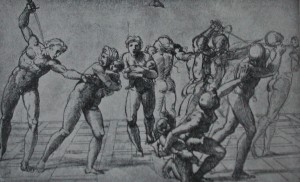
Raphael's Massacre of the Innocents
If we then add to the lay-figure concept the idea of perspective we have defined renaissance syntax. It was a great success up to a point but Rembrandt, probably subconsciously, realized that to express the feelings of his protagonists it was inadiquate. He needed to convey a much more precise sense of the space occupied by his actors in order to “give maximum expression to feeling”. This necessitated a new syntax, of which the “experts” seem oblivious.
A visual demonstration of Rembrandt’s new syntax will be coming shortly on this blog as I cannot point to other sources nor explain it without diagrams.
There is one more painting and hundreds more drawings by Rembrandt around in the world than those acknowledged by the experts. They are probably in museums or private collections but may be in the hands of dealers.
On Youtube you can see Konstam’s model reconstruction of the scene in a barn which Rembrandt observed direct from his group of real people to create his painting now in Munich. The camera then pans round to a reflection of that complex model group seen in a mirror of polished pewter (polished copper would have produced a yet more Rembrandtesque warmth of colour). The reflection shows the subject matter of “The Adoration of the Shepherds” now probably in the basement of The National Gallery (London). It was always accepted as a Rembrandt until the Rembrandt Research Project pronounced that it could not possibly be by the same painter as the Munich Rembrandt.
Amusingly only two objects have to be repositioned; the cow and a little boy with a dog. The adults and a central post in the barn with a basket hanging from it remain as they were, even the spaces between them remain constant.
The complexity of the array and the accuracy of its reflection must prove (beyond reasonable doubt) that Konstam’s long scorned version of Rembrandt’s varied output has triumphed over the establishment version that has tried to impose a level of consistency, which is completely at variance with the recorded character of the artist.
Konstam now comes forward with two long forgotten preparatory drawings for the two paintings which he reasonably claims are therefore by Rembrandt, for certain. The first was published as a Rembrandt by W.R.Valentiner in his 1934 catalogue. The second was recognised as a Rembrandt by H de Groot in 1904 but written off by S.Slive in his Dover publication 1965.
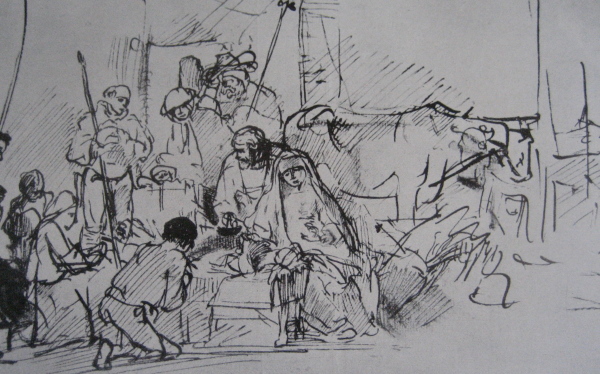
Published as a Rembrandt by W.R.Valentiner in his 1934 catalogue
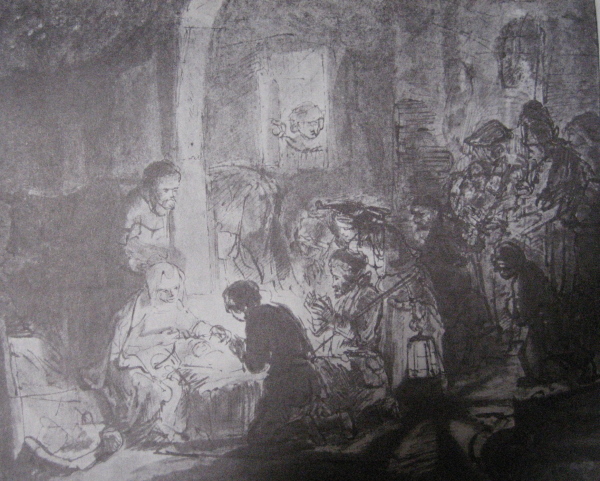
Recognised as a Rembrandt by H de Groot in 1904 but written off by S.Slive in his Dover publication 1965
Konstam points to a particularly beautiful drawn young woman in the drawing wearing a broad brimmed hat and carrying a lantern. The young woman appears again in the National Gallery painting but her hat and lantern are carried by the tall bearded man behind her. This is Konstam’s version of Rembrandt, using live models and mirrors, swapping hats etc.
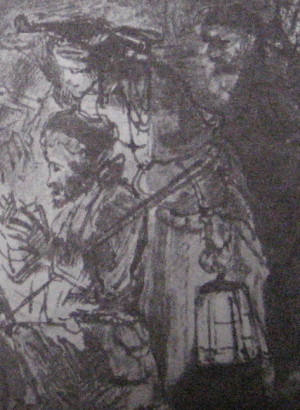 Beautifully drawn woman with hat and lantern |
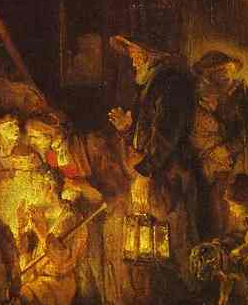 The woman's hat and lantern are carried by the tall bearded man behind her in the National Gallery Adoration |
Over several generations the “experts” have constructed a castle in the air which has finally collapsed because its founded on a series of fallacies. Ninety percent of their judgements from 1904 onwards should be put straight in the waste paper basket. The present scholars should be relegated to pronounce on Warhol and the like. They are fit for nothing else because they are blinkered by their training. It is a sad fact that we see only what we expect to see, in the main.

9am 11 Dec 09
The village of Casole is well advanced in it’s preparations for the Christmas festivities. Would you believe it a village of 950 inhabitants has a temporary ice-skating rink in the castle square. Its put to very good use but after only five days the standard is not yet Olympic. Here is me taking advantage of the lull when everyone else is at supper. It goes on till 11pm.
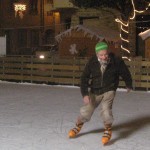
me skating
The live enactment of the miraculous birth is something we do every few years here and this year is one of them. It is usually very well done and bus-loads come from afar to see it. Seventy bods in Biblical dress with plenty of live stock around to make the Christmas story come alive. Cows, donkeys, sheep, hens and on the 6th of January real camels, God knows where they come from.
The via San Michele and the piazzetta in front of the Centro, being the oldest part of the village, are transformed. Not so much as a modern drain-pipe is to be seen; all are masked off with reeds or sacking so we are in a very convincing medieval village if not quite Palestine. Old cantinas are opened up to create workshops for cheese making, dyeing, weaving and spinning (one can see that the old fingers are well practised in those arts) black-smithing and even sculpture are demonstrated. Walking up our street one can truly feel the buzz of a medieval market place. It happens on the 26th 27th of December & 3rd & 6th January, 15.30 – 19.30pm
My “Good Shepherd” was inspired by such a figure with a lamb across his shoulders some years ago. The sculpture is nearly life-size in travertine. He is about to be placed with my other two carvings “The Good Samaritan” and “The Return of the Prodigal Son” on the hill of San Niccolo just outside the village. The church has a delightful Romanesque interior decorated with 17th and 18th century, rustic frescos. I see the hill as a most generous acknowledgement of the second half of my adult life spent here in Casole. I never touched stone after I left art school in Britain till I came here. There is such an abundance of beautiful stone to choose from. I spend more than half my time on it now, I am captivated. The Tuscans certainly know how to use sculpture.
MERRY CHRISTMAS
The aim of this blog is to create a forum of discussion on the present state of art in Britain. Britain seems to be leading the world in the charge of the Gaderine swine.
I am aware of two forums where resistance to “State Art” is strong: the Stuckists and The Jackdaw. But while I salute the splendid spade and foot work both have done in drawing public attention to the gross dishonesty and self-interest of the present regime at the Tate, I feel there is a great need of a third forum where an alternative evolution can be discussed and eventually put in place.
As a former student at Camberwell (1955-7) I look back on that training as a golden age compared to what is available to art students today. I have been revisiting Roger Fry, his Last Lectures, as I regard him as the grandfather of the particular philosophical ambience that distinguished the Camberwell tradition in my time. His influence on Coldstream (head of Camberwell before he went on to the Slade) was crucial to that ambience.
Fry’s insistance on the importance of the abstract or architectonic aspect of a work of art was most apposite to the art of 1900 but I feel that the pendullum of fashion has swung so far in that direction that it is high time to give it a good push towards Humanism. Fry could not have foreseen the depths to which this aspect of his doctrine has sunk: I see the present state of art in Britain as a colossal insult to the intelligence of the majority of us who work or suffer in the dark shadow of the State Art’s massive publicity, so rightly dubbed “Art Bollocks” by The Jackdaw.
Old “Humanism” was the driving force of the Italian Renaissance. It was based on a recognition that Greek art and philosophy had much to teach them about the human condition. I have chosen “New Humanism” as a name in the hope it will bring about a similar renaissance. I mean it to include any art based on observation. The survival of the species depends to a large extent on our ability to see and understand what is going on out there.
Artists tend to be politically naïve or lazy. We have allowed art historians to step in and direct the public face of art, with the result that The Turner Prize, for instance, is only of interest to a favoured few who dominate the public face of art in Britain thereby. I hope this blog will become a forum where alternatives can be intelligently discussed and eventually replace the present horrors. Any ideas?
Please participate and inform your friends.
Yours truly, Nigel Konstam
STOP PRESS A NEW FILMLET ON YOUTUBE
Mirrors used by
Rembrandt for his two paintings of
The Adoration of the Shepherds
ALSO available is Nigel’s 5 minute film on The School of Adrea Verrocchio – Renaissance Sculptor who “restored worth and value to Florentine art at a time when those qualities were on the point of extinction”.
Two quotes from the Phenomenon of Man, (P.Teilhard de Chardin) “Seeing. We might say that the whole of life lies in that verb.”p.31 “a truth once seen, even by a single mind, always ends up by imposing itself on the totality of human consciousness.” p.218
So why is it so difficult to transmit such a truth? I have been at it half a life-time (since 1974 to be precise) and still have not got it through. Thank God for internet, it may give me half a chance. The answer to my question is - because many others think it is their territory and I, a mere sculptor, should not trespass. There is the other complication that what I have seen makes them (the many) look rather foolish for not having seen that truth for themselves. Furthermore that blindness goes back several generations.
I will be aiming at three individuals who made up a team of “experts” in charge of the main collections of Rembrandt’s drawings at The British museum, The Rijksmuseum and the Boymans in Rotterdam. They have produced three new catalogues of their collections which follow the fashion set by The Rembrandt Reseach Project (RRP) of reducing that great master’s corpus by de-attribution, to a mere shadow of it’s former self. The master’s reputation has naturally followed.
I am in the process of writing a commentary on all the drawings I believe to be by Rembrandt and a few which the “many” favour but I do not. I expect the number of Rembrandts in my commentary to be at least twice as large as a catalogue any of these three might be writing (God forbid).
The emphasis in my commentary will be on Humanism and what Fry called “significant form” a term which was the rage while Fry was around but now out of fashion. I call it “visual syntax” by analogy with literary criticism. Today’s “experts” seem hardly aware of syntax yet no real understanding of Rembrandt’s drawings is possible without it. He has a syntax all his own which I will be at pains to make clear in these pages. Very fortunately computer technology has made possible an explanation that was not available to Fry. Some may well still be guessing what he was on about.
The team of Rembrandt experts I am sure are all very cultured in the sense of being well read, knowledgeable about music, poetry and above all about the literature produced by their fellow art historians. But of what we can term visual culture, that is the culture of artists, I do not detect a smattering, scarcely a vestige. No doubt all have been through the Art Historical mill at smart universities and most probably come out near the top of their year because they have thoroughly adsorbed what their professors had to offer, and there lies the trouble. They come through the mill blinkered by the accumulated prejudices of their predecessors. Unable to see for themselves, they chew over and add to the accumulation of half truths. Rembrandt studies are a vicious spiral that has been spiraling downwards for over 100 years. It must be stopped.
No new knowledge is allowed to enter this closed circuit. This particular artist has been banging at their door for half a life-time and has been roundly snubbed and occasionally robbed of his insights. What I have discovered about Rembrandt’s practice would become established fact immediately in scientific circles because of the weight of evidence (see www.saveRembrandt.org.uk). Yet it has hardly penetrated the mentality of Art History beyond the above mentioned thefts. My evidence has been most unsatisfactorily rebutted in The British Museum catalog. Unsatisfactory because there is no mention of the fact that Rembrandt’s use of mirrors has been noted in nearly 100 cases, which statistically must make it a dead cert.
Furthermore, Max Wykes-Joyce wrote of my exhibition at Imperial College (The International Herald Tribune 27.1.76 ) …with the use of maquettes, photographs, mirrors and a text, illustrates what Konstam believes to have been the working methods of Rembrandt, Poussin and others, and which by implication, contradict much of 20th century criticism and scholarship. Certainly as a working artist the case he makes for the re-dating and reconsideration of many of Rembrandt’s drawings is strong.” And later…”certainly the exhibition is a seminal one that should not be lightly dismissed.” The Observer headlined a quarter page article “The Rembrandt Revelation”. Two very eminent art historians (Gombrich and Montagu) assisted me in writing the text that was published in The Burlington (Feb ‘77). The editor (B. Nicholson) wrote in his letter of thanks “ I find the evidence you have accumulated of the greatest possible interest, and so I am sure will Rembrandt scholars, who must now get down to revising the corpus of drawings!” A similar text was published in Dutch (Rembrandthuiskroniek 1978.1) And yet I believe since this auspicious beginning the whole idea has been brushed under the carpet without discussion.
I WOULD BE VERY GLAD TO HEAR FROM ANYONE WHO HAS STUDIED REMBRANDT AT UNIVERSITY LEVEL, WHETHER THIS IS SO.
I named my Art School in Tuscany Italy after the famous ‘School of Verrocchio’ because of my great admiration for the Renaissance Sculptor Andrea Verrocchio who ran the greatest Art school ever known (attended by Leonardo da Vinci, Perugino, Lorenzo di Credi, Domenico Ghirlandaio). Adolf Beyersdorfer in 1876 wrote of Andrea Verrocchio: “Next to his pupil Leonardo, his (Verrocchio’s) is the greatest artistic character that has ever existed. The lofty and strict principles of his studio brought back worth and value to Florentine Art at a time when these qualities were on the point of extinction”.
My 5 minute video about the School of Verrocchio is now available on YouTube
We have recently completed a DVD about one of the all time greats in sculpture. You are unlikely to have ever heard of him. He started his great work as architect and sculptor on Orvieto Cathedral in 1303 and some of the sculpture was in place by 1307 that is some years before Giotto’s Arena Chapel or Duccio’s Maesta. He is so original and advanced technically that he does not fit the mould of art history’s development, so it is easier to leave him out all together!
Technically his work in relief is the missing link between the Pisani (Nicola & Giovanni) and Ghiberti’s “The Gates of Paradise” on The Baptistry in Florence. More importantly he speaks to us through a common humanity more immediately and comprehensively than any of his contemporaries. His observations of humankind are truly delightful. He retells the Bible stories with gravity, humour and even one feels with a touch of criticism for God’s pre-feminist attitude to the fair sex.
How could such a master be neglected? It was in answering this question that I believe I have stumbled upon the great hole in art criticism today. See “A Manifesto for New Humanism” below.
The sculptor’s name is Lorenzo Maitani. You can find splendid photos of his work in “La Facciata del Duomo di Orvieto” (SilvanaEditoiale 2002) or in our DVD see below. If you go to Orvieto take binocculars, the reliefs start at eye-level but go up about 10m, there are 112sq.m of them!
DVD will soon be available through the Orvieto Tourist Board.
